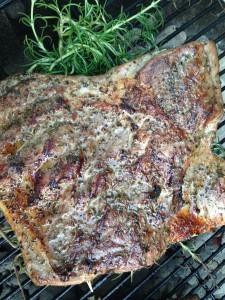Snails Then and Now
As a Francophile teenager growing up in Southern California I desperately wanted to try what seemed to me the ultimate French dish, snails. On a school field trip to Los Angeles I had my wish when were taken to Taix, a famous French Restaurant in Echo Park. I ordered Escargot de Bourgogne (they are still on the menu), and was relieved not only that I could eat them, but that I liked them. After all, what’s not to like about all that garlic and butter. Since that long ago day, I’ve eaten hundreds of snails in a dozen or so different ways. I’ve even hunted them down by flashlight on rain-washed roadsides in Provence, then raised the captured snails in a cage, feeding them on wild thyme and bran before cleaning, cooking and consuming them.
In Provence, there is a long history of eating snails, with the earliest evidence dating back more than 12,000 years ago. The remains of ashes and snail shells, indicating the snails were cooked in coals, have been found in the aprons of prehistoric caves in the region of Haute Provence, dating to at least 11, 000 B.C. Archeologists have unearthed several sites where such an impressive number of snail shells have been found that the sites are referred to as Mesolithic escargotieres, or snail farms.
The people of Provence have continued the tradition of cooking snails in the coals, as well as developing more elegant culinary expressions. I have been told that up until the 1950s and 1960s, it was common to cook snails for lunch while working in the vineyards. The workers would build a fire of grape prunings in a clearing and place a rack over the coals to hold the snails, just the way their grandparents and great grandparents did. The snails were picked from their shells with a pin or a needle and ideally would have been eaten with aïoli alongside, still a popular combination in the region. In Marseilles, in the 1930s, snail vendors plied their wares in the streets, selling paper cones of cooked snails accompanied by a pick.
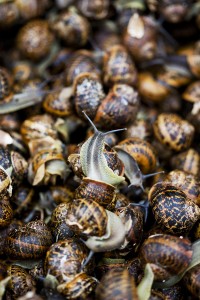 In the old days, limancieres were wooden cages constructed specifically for the keeping of captured snails.The cages were covered with a metal grill and had a small door built at the bottom of one end. You can find these sometimes at flea markets. People had several limancieres, one for each different kind of snail. Although I have never seen one, I’ve read there were once terracotta escargotieres, which were jar-shaped and fitted with pierced lids. The gathering and keeping of snails were part of the stock and store of the self-sustaining Provençal farm.
In the old days, limancieres were wooden cages constructed specifically for the keeping of captured snails.The cages were covered with a metal grill and had a small door built at the bottom of one end. You can find these sometimes at flea markets. People had several limancieres, one for each different kind of snail. Although I have never seen one, I’ve read there were once terracotta escargotieres, which were jar-shaped and fitted with pierced lids. The gathering and keeping of snails were part of the stock and store of the self-sustaining Provençal farm.
Today, probably the most popular presentation of snails, both at home and in restaurants is the ubiquitous Escargots Bourguignon. Snails, Burgundy style, are stuffed back into their shells after they are cleaned and cooked, then the shell’s opening is filled with a mix of butter, garlic, and parsley and baked until the butter melts into savory pools. As long ago as the 1850s this dish was renowned in Paris, but referred to then as Escargots Provencale, because the snail farms of Provence were the provenance of the snails. However, by the end of the 19th century, the snails were coming from Burgundy and the dish was to be known forevermore as Escargots Bourguignon.
As Provencal chefs and home cooks alike search for local, fresh, quality ingredients, snail farms have again become a profitable small business in Provence. Here and there you’ll come across a sign for a snail farm that sells direct to the public, and snails may be offered fresh at the open markets too. Like mushrooms which they resemble somewhat in texture, snails are adaptable to sauces, soups, omelets, and stuffings.
At a restaurant in the hinterlands of Haute Provence I was once surprised with a two-thimbleful taste of snail and parsley soup, an amuse offered by the chef. At another I began my meal with ‘Profiterole d’escargots” which translated to the plate as snails bathed in a sauce of fresh goat cheese, shallots, and chives and tucked into savory, bite-sized cream puffs, served three to a bowl resting on a swirl of the sauce. Not far from Lyon, the gastronomic capital of France, I had shitake mushrooms stuffed with snails, and at a restaurant in Nice striving to earn its first star, I feasted on an appetizer plate of beignets des escargots, fresh snail fritters, accompanied by lemon aïoli for dipping, and finger bowls to finish up.
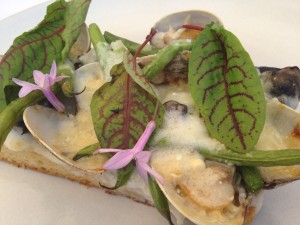
And just last week, at Angele Restaurant in Napa, California I had a Tartine with Escargots, Bechemel Sauce and Clams. The possibilities are neverending when it comes to snails.
Snail Beignets with Garlic Mayonnaise
This is my version of the snail beignets I had in Nice, a twist on Escargot Bourguignon, and a delicious way to eat garlic, parsley, and butter.
For the Aïoli
To make the aïoli, using a pestle, crush four cloves of garlic in a mortar with a pinch of coarse sea salt until it is a paste. If you have a large mortar, continue with this. If not, remove the crushed garlic to a bowl. Whisk in three large egg yolks, then drop by drop, drizzle in about a half-cup of extra-virgin olive oil, whisking continuously. As the aioli begins to thicken, the oil can be added in a stream. If you are using a mild, Provençal-style olive continue whisking in another one-quarter cup of it. If the olive oil is a stronger one, whisk in grapeseed or sunflower oil instead. When the aïoli is stiff, set aside. It can be made a day ahead if you want, but it does become stronger with time.
For the beignets, start with about two handfuls of snails. Canned ones are perfectly suitable. Rinse, drain them well, then coarsely chop them. Put them in a bowl with a tablespoon or two of minced shallot and handful of minced parsley, along with a little sea salt and coarsely ground fresh pepper. Add a handful of flour, a dollop or two of crème fraiche and a large egg. Whisk all the ingredients together to make a stiff paste.
In a saucepan or deep-fryer, heat about two inches of olive oil over medium heat. When it is hot, drop the batter by large tablespoons into the oil, but don’t crowd them, frying them until they’re golden, just a few minutes. Remove them to paper towels to drain, and repeat until all are fried. Serve them hot or warm with the aïoli.
Makes about 12 fritters to serve 4 as an appetizer.
Pork Belly Story
A friend of mine hand -raised 12 piglets whose mother died giving birth. My friend nursed them first in her back yard, then when they were old enough to eat on their own, took them out to her country property. There they led a grand, free life, snacking on local almonds and other delicacies. Eventually they grew up and went to market.
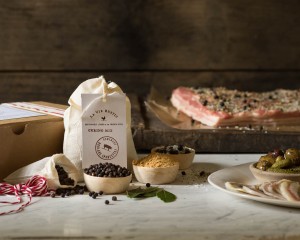
My daughter bought us a half share, and among the meaty goods was a pork belly. I cut it in half, seasoned one half with the curing mix from La Vie Rustic’s DIY Roulade set lavierustic.com) for photographer Thomas Kuoh(Kuohphotography.com) to photograph. Click on the photos to see how gorgeous his photos truly are.
I liberally seasoned the other half with Herbes de Provence, grey sea salt, and freshly ground black 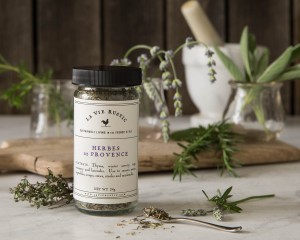 pepper and grilled it that night for dinner on my sturdy Weber. I thin sliced the meat, and served it with oven roasted potatoes and a simple green salad.
pepper and grilled it that night for dinner on my sturdy Weber. I thin sliced the meat, and served it with oven roasted potatoes and a simple green salad.


